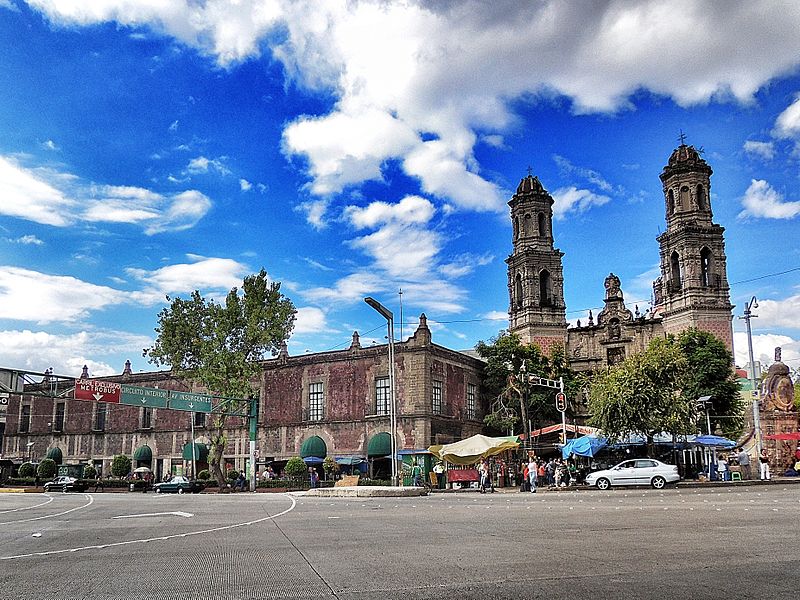
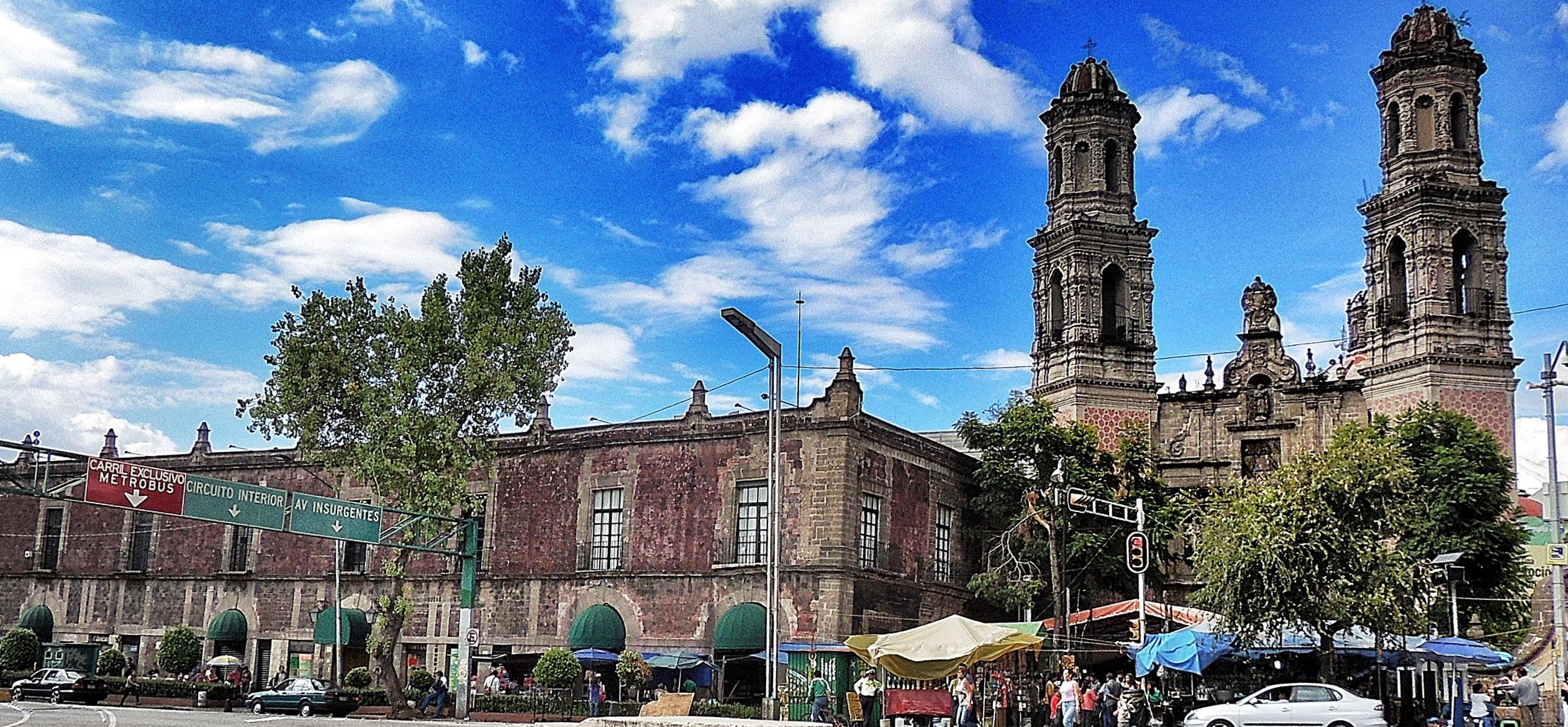
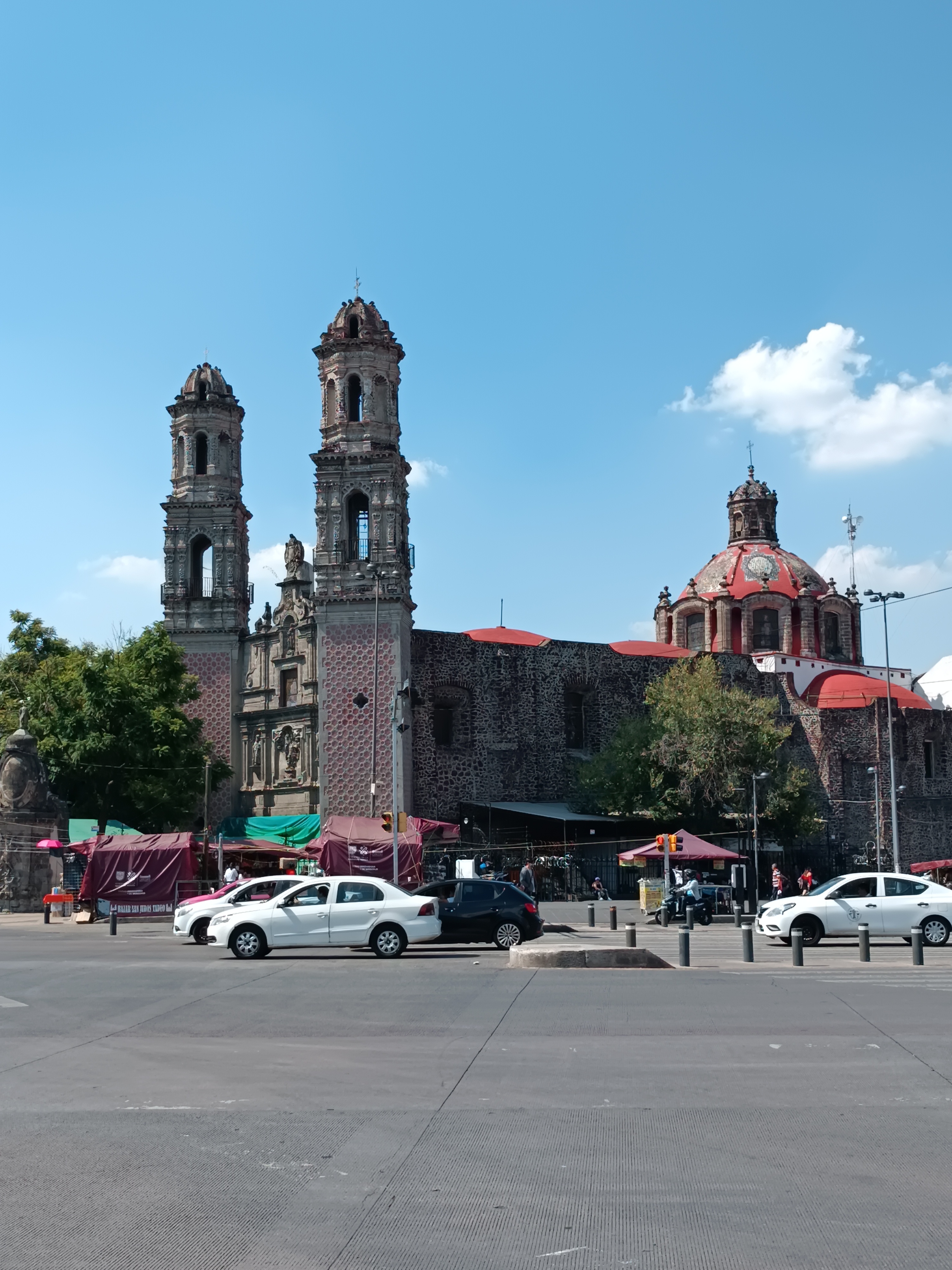
圣伊波利托和圣卡西亚诺神庙(Temple of San Hipólito and San Casiano)的双塔和周围的建筑群背后有无数故事。如今,这里虽然是San Judas Tadeo(英语为Saint Jude)狂热追随者的主要聚会场所,但这座神庙的历史可以追溯到征服时期,而且并不止于此。
这是旧(超旧)的墨西哥-塔库巴公路(Calzada Mexico-Tacuba)的起点,这条堤道从特诺奇蒂特兰通往的邻近城市塔库巴,当时称为特拉科潘。因此,这里的历史几乎无法用一页文字回顾,但我们尽量尝试。
从这里开始通往塔库巴的街道长期以来被称为“阿尔瓦拉多桥”(Puente de Alvarado)。1520年6月30日,西班牙人正是在这里逃离了特诺奇蒂特兰。阿尔瓦拉多(Alvarado)留下来负责这座城市,而科尔特斯((Cortés))则说服一群派来逮捕他的西班牙人与他一起进行掠夺。2021年,这里更名为墨西哥-特诺奇蒂特兰公路(Calzada Mexico-Tenochtitlan)。
在今天的十字路口有一条护城河。在这里,满载黄金掠夺品的这群西班牙人而蒙受了重大损失。他们花了一年时间才重新集结、返回,并于1521年征服了特诺奇蒂特兰。传说,科尔特斯沿着堤道继续前行,他在波波特拉停下来为自己的损失哭泣。
据说,第二年,科尔特斯就下令在这里建造一座寺庙来纪念许多阵亡者。这一处遗址旨在纪念圣伊波利托和圣卡西亚诺,纪念他们的节日是在8月13日(即特诺奇蒂特兰城沦陷当日)。
希波吕托斯(Hippolytus)是一位3世纪的烈士。卡西亚诺(Casiano)是一名教师,因拒绝崇拜罗马偶像而惨遭折磨而死。
科尔特斯和西班牙人对高架堤道两侧出现的土地很感兴趣。这只是通往塔库巴沿途分布的众多果园和农场中的一个收容所。
1581年开始,原来的隐修院重建成一座神庙,大约在那时,又为穷人、老人和精神不健全的人增设了收容所。
每年8月13日的彭东大道(Paseo del Pendón)游行是一种效忠王室的游行,纪念特诺奇蒂特兰城的沦陷。在殖民时期的大部分时间里,人们都会庆祝这一活动。每年,游行队伍从今天的国家宫(National Palace)出发,一直道圣伊波利托(San Hipólito)。
建筑
我们如今看到的这座神庙于1599年开始动工,直到1740年才竣工。
部分地基的历史可追溯至1528 年。
整个结构由特佐特尔火山岩、康托尔采石和石灰砂浆建造。
教堂有一个拉丁十字形的中殿,地板铺有马赛克。
这些塔楼的立面呈45度旋转,在这座城市中可谓独具一格。
塔楼装饰有西班牙阿哈拉卡装饰。
主入口上方的中央空间是圣伊波利托浮雕。
另外两个人物是圣安东尼修道院院长(Saint Anthony Abbot)和帕多瓦的圣安东尼(Saint Anthony of Padua)。
圣母玛利亚的画像位于上个世纪制作的彩色玻璃窗中。
圣伊波利托西侧的医院大楼经历了许多变化。
1843年,Antonio López de Santa Anna将军将这里用作军营,并出售了底楼。
1847年至1850年间,这里是市立医院的所在地。
1850 年至1853年,医学院将这里当作总部,改革法(1857年)出台后,这里出租出去。
翻修工程启动后,教堂直到1893年之前都一直关闭。
著名的1913年灾难十日(Ten Tragic Days)期间,教堂大门紧闭。教堂遭到严重破坏,直到1919年才重新开放。
1931年,这里成为国家纪念碑(National Monument)。
20世纪50年代,这里专门修建了一座礼拜堂供奉圣犹大塔德奥(San Judas Tadeo)。
1974年,一些被认为是真正的征服者的遗骸被移入教堂的地下室。
随着圣犹大塔德奥(San Judas Tadeo)越来越受欢迎,1982年,他的画像被移至主祭坛,恰好摆放在圣伊波利托和圣卡西亚诺的画像中间。
这位绝望事业的守护神(Patron Saint of Hopeless Causes)的纪念日是10月28日,但信徒们每年都会在每个月的28日表达追思。大多数时候,在主入口处,游客都可以看到摊贩在出售与圣犹大塔德奥(San Judas Tadeo)有关的虔诚物品。
就像街那头的圣韦拉克鲁斯教堂(Church of Santa Veracruz)一样,圣伊波利托神庙(Temple of San Hipólito)在历史上的地位复杂而充满争议。也许仅仅忽略这段矛盾且常常令人痛苦的历史还不够,大家可以直接调查,尽可能地表达质疑。
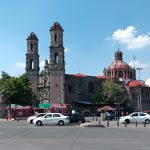 Troops commanded by Hernán Cortés defeated the city of Tenochtitlan on August 13, 1521. The Christian saints' calendar of that time marked the feast of Saint Hippolytus the Martyr on that day. The soldiers thus received plots of land in the city as rewards for their work.
A soldier named Juan Garrido received some land on the outskirts of the city, where the Spanish troops had passed on their escape on June 30, 1520 during a passage remembered as the "Sad Night." On his land, Garrido built a hermitage and gathered the skeletal remains of the fallen from that sad night. He named his hermitage for the martyrs.
In 1564, the Mexico City Council received an offer from the Pope to acquire the remains of Saint Hippolytus Martyr for 800 pesos of common gold. The temple to San Hipolito and San Casiano, as patrons of the Hispanic conquest of the city, was then erected over the chapel of the martyrs.
In that church was a banner with which Cortes took to the Mexica capital, so that every year - over three centuries of Spanish domination - "The walk of the banner" was carried out. The entire population of the capital participated. The current temple was opened in 1767. In the atrial wall of the temple of San Hipólito, architect José Damián Ortiz de Castro erected a monument to the sad night. It is a wall a little more than two meters high, known as the "Monument of the Labrador" recalling a legend of a Nahua farmer who tried to warn Moctezuma II of the consequences of his actions.
The history of the old hospital is also unique. Bernardino Álvarez, a Spanish soldier with a great fortune obtained through games and frauds, bought some vacant land next to the temple of San Hipólito. By 1567 the archbishop of Mexico granted him a license to found a hospital. The institution was dedicated particularly to the elderly and the insane. Soon more people became involved in its maintenance until the Congregación de La Caridad y San Hipólito was created. It was suppressed by the Cortes de Cádiz in 1820.
Troops commanded by Hernán Cortés defeated the city of Tenochtitlan on August 13, 1521. The Christian saints' calendar of that time marked the feast of Saint Hippolytus the Martyr on that day. The soldiers thus received plots of land in the city as rewards for their work.
A soldier named Juan Garrido received some land on the outskirts of the city, where the Spanish troops had passed on their escape on June 30, 1520 during a passage remembered as the "Sad Night." On his land, Garrido built a hermitage and gathered the skeletal remains of the fallen from that sad night. He named his hermitage for the martyrs.
In 1564, the Mexico City Council received an offer from the Pope to acquire the remains of Saint Hippolytus Martyr for 800 pesos of common gold. The temple to San Hipolito and San Casiano, as patrons of the Hispanic conquest of the city, was then erected over the chapel of the martyrs.
In that church was a banner with which Cortes took to the Mexica capital, so that every year - over three centuries of Spanish domination - "The walk of the banner" was carried out. The entire population of the capital participated. The current temple was opened in 1767. In the atrial wall of the temple of San Hipólito, architect José Damián Ortiz de Castro erected a monument to the sad night. It is a wall a little more than two meters high, known as the "Monument of the Labrador" recalling a legend of a Nahua farmer who tried to warn Moctezuma II of the consequences of his actions.
The history of the old hospital is also unique. Bernardino Álvarez, a Spanish soldier with a great fortune obtained through games and frauds, bought some vacant land next to the temple of San Hipólito. By 1567 the archbishop of Mexico granted him a license to found a hospital. The institution was dedicated particularly to the elderly and the insane. Soon more people became involved in its maintenance until the Congregación de La Caridad y San Hipólito was created. It was suppressed by the Cortes de Cádiz in 1820.
Heart of México Walking Route: Manuel Tolsá - Santa Veracruz
< < MUNAE | The Ancient Route > >
Proyecto “Corredor de Cultura Digital”.
Nombre de la investigación: Investigación Centro Histórico, Monumentos, Edificios y Puntos de Interés (2023)
Dirección de investigación y diseño de Rutas: Acércate al Centro A.C. Guadalupe Gómez Collada
Coordinación e investigación histórica: Fideicomiso del Centro histórico Dir. Maestra Loredana Montes
 55 5510 4796
55 5510 4796
 https://www.facebook.com/pg/sanhipolitomx/
https://www.facebook.com/pg/sanhipolitomx/
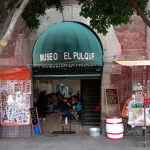
相近 0.01 kms.

相近 0.05 kms.
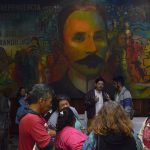
相近 0.11 kms.
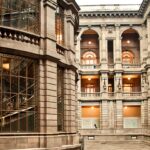
The National Art Museum in Mexico City's Centro Histórico is always going to be a holiday highlight.
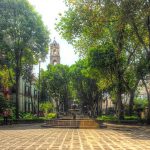
One of Mexico City's most beautiful historic squares, it's a meeting place for booklovers and dealers.
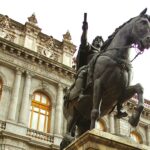
Perhaps more controversial than Sebastián's big yellow replacement, Charles the Fourth is still riding high.
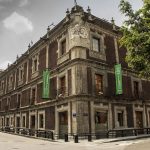
One of the most painstakingly restored 17th century complexes in the City, MIDE tackles a tough subject with style.

The National Print Collection is an enormous trove of important printed works from a wide variety of techniques.